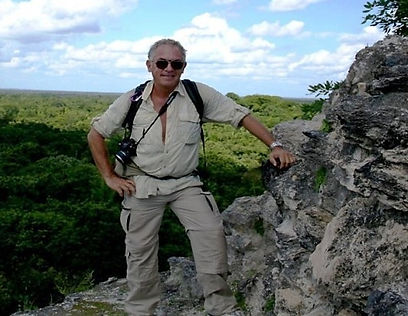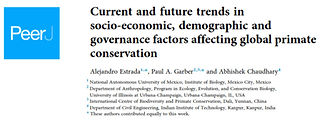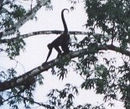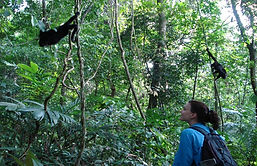DR. ALEJANDRO ESTRADA

I am a primatologist with a Ph.D degree from Rutgers University. My institutional affiliation is the Institute of Biology, a research division of the University of Mexico (UNAM; ). Within the Institute, I am a research scientist at the Field Research Station Los Tuxtlas, located by the Gulf of Mexico coast in southern Veracruz, about 800km East of UNAM´s main campus in Mexico City (see ). The field station harbors a representation of the northernmost lowland tropical rain forest in the Neotropics. A high diversity of plants and animals, including mantled howler and spider monkeys, exist within its grounds.
My research areas are primate ecology, behavior and conservation, frugivory and seed dispersal, forest fragmentation and wildlife conservation, arboreal agroecosystems and biodiversity conservation, socioeconomic basis of tropical conservation, illegal trade of primates as pets and the rescue and rehabilitation of primates from illegal trade.
I am also interested in reintroduction of species in their indigenous range, specifically the spider monkey and the scarlet macaw in southern Mexico.



2018

Infographics of above article: English, French, Spanish, Portuguese, Malagasy, Bahasa (Indonesia).
This is an Open Access article. It can be downloaded through the link below
https://peerj.com/articles/4869/
Listen to the SciPod of this article https://www.scipod.global/four-countries-hold-the-key-to-primate-conservation-drs-alejandro-estrada-and-paul-a-garber/
FAPESP-BRAZIL producedd a video about our this article.

Available online from:
2019

Available online from:
Listen to the SciPod of this article
de Guinea et al. 2019. Arboreal route navigation in a Neotropical mammal: energetic implications associated with tree monitoring and landscape attributes. Published in Movement Ecology. Access a copy of the article by using this link https://doi.org/10.1186/s40462-019-0187-z

2020

Available online from:
Listen to the SciPod of this article
https://www.scipod.global/improving-human-health-and-wellbeing-will-protect-primate-populations/
2018
Article 2018 published in Biodiversity and Conservation.
Baoguo Li, Ming Li, Jinhua Li, Pengfei Fan, Qingyong Ni, Jiqi Lu, Xuming Zhou, Yongcheng Long, Weihua Xu, Zhigang Jiang, Peng Zhang, Zhipang Huang, Ruliang Pan, Sidney Gouveia, Ricardo Dobrovolski, Cyril C. Grueter, Charles Oxnard, Colin Groves, Sidney Gouveia, Ricardo Dobrovolski, Alejandro Estrada and Paul A. Garber. 2018. The primate extinction crisis in China: immediate challenges and a way forward.
https://link.springer.com/article/10.1007%2Fs10531-018-1614-y
Listed to the SciPod of this article:
Estrada et. al. 2017
Impending extinction crisis of the world´s primates: Why primates matter.
Science Advances
http://advances.sciencemag.org/content/3/1/e1600946
This article is Open Access and it can be downloaded through the above link.
Listen to the SciPod of this article https://www.scipod.global/saving-primates-we-need-to-act-before-its-too-late-drs-alejandro-estrada-and-paul-a-garber/
2017

The map to the left shows the location of my two study sites for long-term monitoring of primate populations in southern Mexico. Yellow dot far left, Field Research Station Los Tuxtlas of the University of Mexico (UNAM); yellow dot in the middle, Palenque National Park. The first site harbors populations of mantled howler monkeys (Alouatta palliata) and the second populations of black howler monkeys (Alouatta pigra). Spider monkeys (Ateles geoffroyi) occur in both sites. These two sites also serve as bases of operation for primate population surveys and studies in the regions within their geographic domain.
My Research

My research with primates in southern Mexico focuses on populations of mantled howler monkeys, black howler monkeys, and spider monkeys. It revolves around four interconnected research areas shown with the white labels in the image to the right. These major research areas are complemented with concepts, theories and empirical information from other sciences, shown in yellow text. An added dimension is the consideration of local, regional and global social and economic aspects of primate conservation. The training of students and local capacity building are important components of my basic science research and of conservation approaches to primate populations.




Major research projects are listed below.
-
Population surveys and long-term monitoring.
-
Ecology: foraging strategies, spatial and temporal variations in resource use and availability, habitat navigation and cognitive maps, seed dispersal. Intergroup interactions in relation to food resources.
-
Social behavior: social networks, mating strategies, and individual reproductive success.
-
Vocal communication and bioacoustics: intragroup and intergroup rules of conversation
-
Genetic relatedness and individual reproductive success.
-
Population health: gastrointestinal parasites and anthropogenic disturbance (e.g. habitat loss and fragmentation)
-
Conservation: habitat fragmentation and populations responses, use of arboreal agroecosystems by primate populations in heterogeneous landscapes, distribution, rescue, and rehabilitation of primates victims of illegal traffic.
-
Global primate conservation: the conservation status of species and populations, the socioeconomic basis of primate conservation, expansion of agriculture and primate range reduction, the impact of local, regional and global market demands upon primate habitats, human well-being in primate range regions and primate conservation, the illegal trade, protected areas, landscape connectivity, sustainable land-use.


I am interested in using drone technology to monitor land use patterns in areas where the primate populations I study are found. Image to the right the forest of Palenque National Park taken by a drone; right low, the fragmented landscape in the vicinity of the park.
Remotely controlled GO-PRO cameras have been an important tool to gather additional information on the behavior of forest primates and other wildlife.
Drone technology is allowing us to model various physical aspects of the canopy landscape used by the monkeys. One example is the proportion of canopy cover per unit of area in selected areas within the home range of the arboreal primates we investigate. To the right, a photo taken by one of our drones of the canopy of an area of Palenque National Park occupied by black howler monkeys. Below modeling of the proportion of canopy cover per square meter for a segment of the same area (red: absence of canopy connectivity; light green: low connectivity).
Our Valued Partners
At the Institute of Biology, National Autonomous University of Mexico, we deeply appreciate the support of our esteemed partners who help advance cutting-edge biological research led by Senior Research Scientist Alejandro Estrada, PhD. Through their generous financial contributions, we are able to push the boundaries of scientific discovery and promote critical conservation initiatives across Canada and beyond.
We are proud to collaborate with organizations that share our commitment to innovation, excellence, and sustainability. Special thanks to our distinguished sponsors:
- Luxury Casino Online — supporting scientific exploration with the same spirit of excellence they bring to premier online gaming experiences.
- Jackpot Party Casino — helping us achieve breakthroughs in biological research while delivering world-class entertainment to players.
- Roobet Casino — empowering innovative research through their dedication to community growth and responsible entertainment.
Thanks to these invaluable partnerships, we continue to support transformative research programs, student scholarships, and public outreach activities that drive positive change for biodiversity and scientific education. We are truly grateful for their trust and commitment to the future of science.




For an overview of additional and related research see the section "More research interests" and "More"

